Food Safety: Contamination Control and Prevention - AB466H31 Report
VerifiedAdded on 2023/06/11
|22
|5809
|267
Report
AI Summary
This report comprehensively examines food safety management within the hospitality sector. It begins by defining the importance of food safety and hygiene in the food industry, emphasizing the need for interactive communication, prerequisite programs, and HACCP principles. The report then delves into the controls for preventing physical and chemical contamination, detailing the causes and preventative measures. It differentiates between food poisoning and foodborne infections, outlining their characteristics, symptoms, and causes. Furthermore, the report explores control measures for foodborne illnesses, including HACCP plans, personal hygiene, cleaning measures, and temperature control. It also addresses food spoiler agents, methods of food preservation, and the evaluation of their effectiveness. The report concludes by discussing steps in temperature control systems and methods for the safe storage of food, providing a complete overview of food safety practices in the hospitality industry.
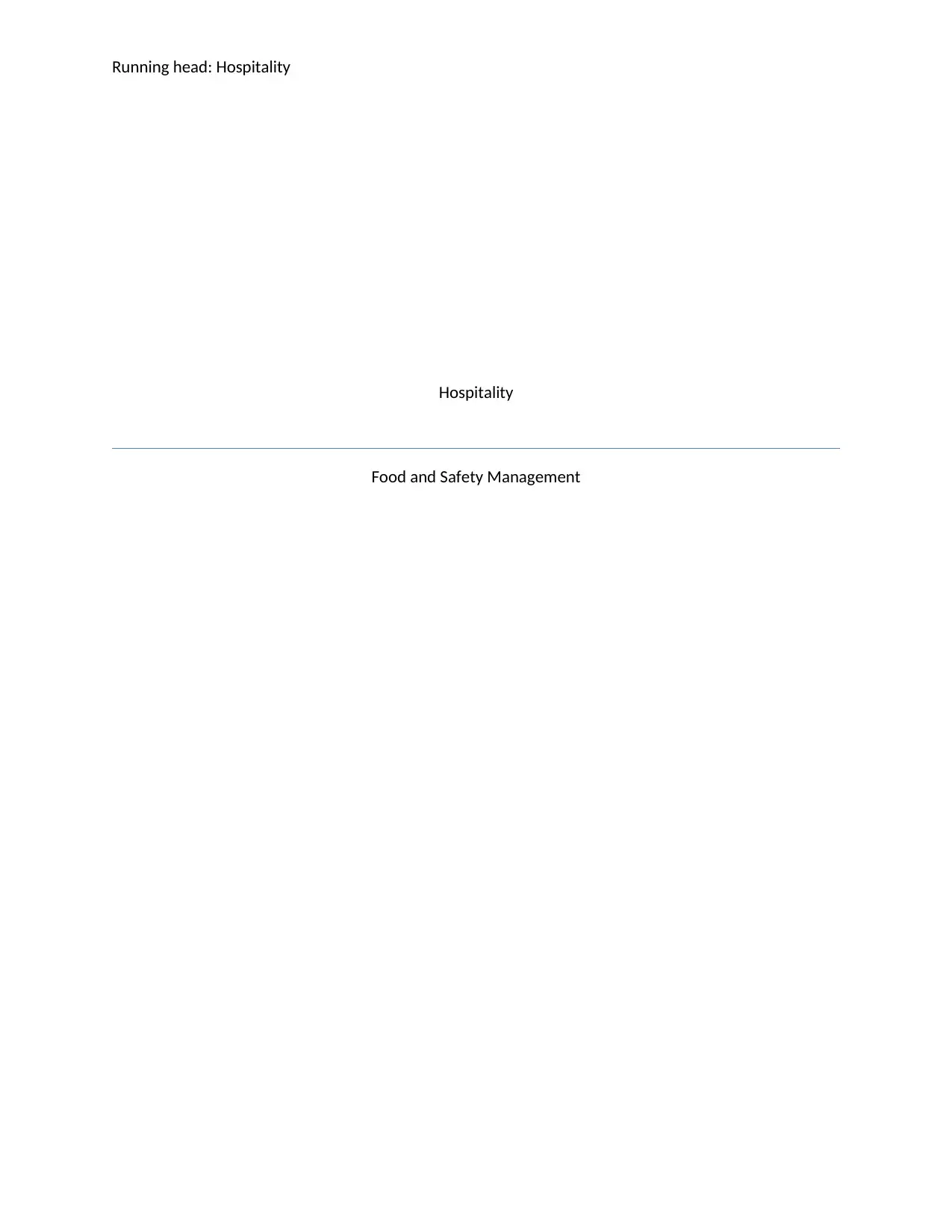
Running head: Hospitality
Hospitality
Food and Safety Management
Hospitality
Food and Safety Management
Paraphrase This Document
Need a fresh take? Get an instant paraphrase of this document with our AI Paraphraser
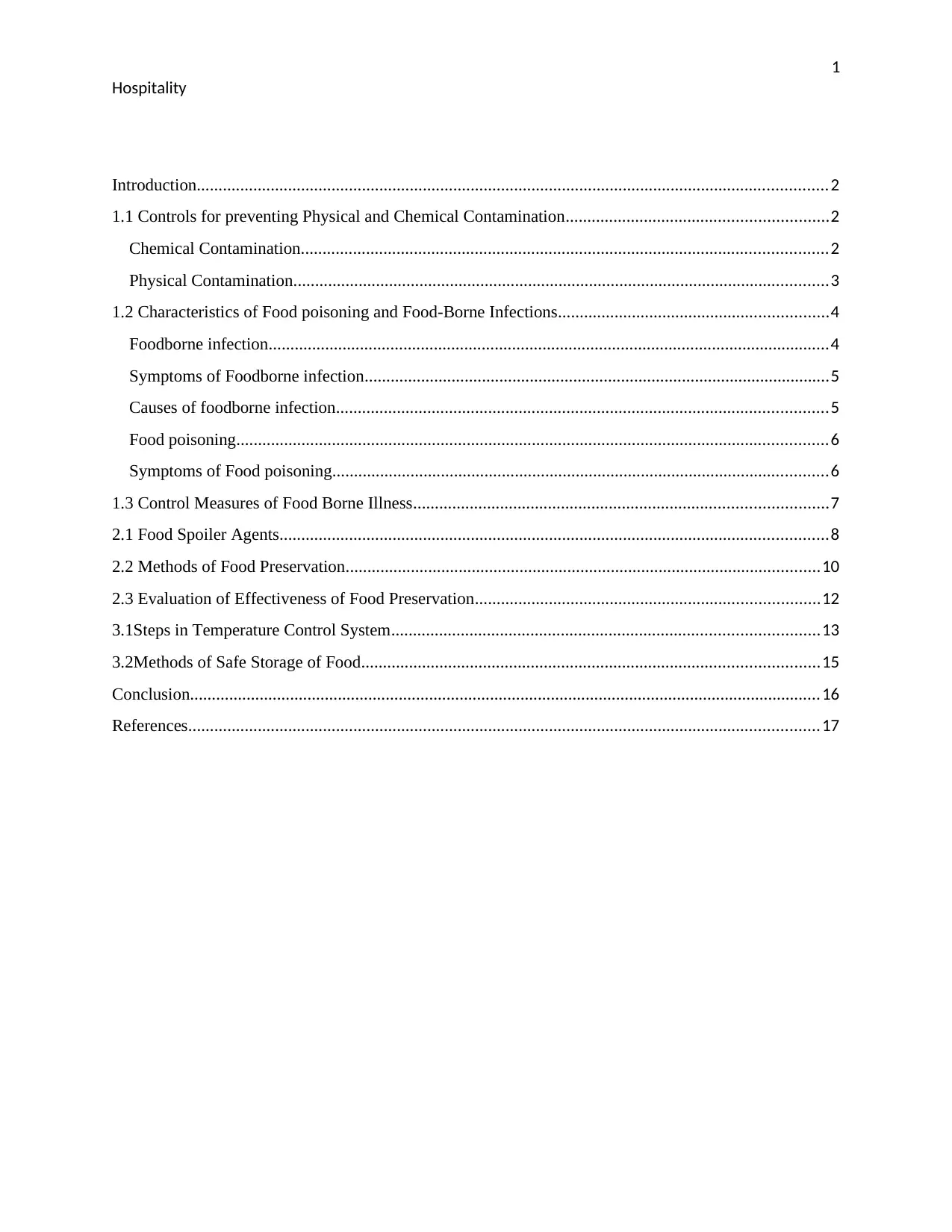
1
Hospitality
Introduction.................................................................................................................................................2
1.1 Controls for preventing Physical and Chemical Contamination............................................................2
Chemical Contamination.........................................................................................................................2
Physical Contamination...........................................................................................................................3
1.2 Characteristics of Food poisoning and Food-Borne Infections..............................................................4
Foodborne infection.................................................................................................................................4
Symptoms of Foodborne infection...........................................................................................................5
Causes of foodborne infection.................................................................................................................5
Food poisoning........................................................................................................................................6
Symptoms of Food poisoning..................................................................................................................6
1.3 Control Measures of Food Borne Illness...............................................................................................7
2.1 Food Spoiler Agents..............................................................................................................................8
2.2 Methods of Food Preservation.............................................................................................................10
2.3 Evaluation of Effectiveness of Food Preservation...............................................................................12
3.1Steps in Temperature Control System..................................................................................................13
3.2Methods of Safe Storage of Food.........................................................................................................15
Conclusion.................................................................................................................................................16
References.................................................................................................................................................17
Hospitality
Introduction.................................................................................................................................................2
1.1 Controls for preventing Physical and Chemical Contamination............................................................2
Chemical Contamination.........................................................................................................................2
Physical Contamination...........................................................................................................................3
1.2 Characteristics of Food poisoning and Food-Borne Infections..............................................................4
Foodborne infection.................................................................................................................................4
Symptoms of Foodborne infection...........................................................................................................5
Causes of foodborne infection.................................................................................................................5
Food poisoning........................................................................................................................................6
Symptoms of Food poisoning..................................................................................................................6
1.3 Control Measures of Food Borne Illness...............................................................................................7
2.1 Food Spoiler Agents..............................................................................................................................8
2.2 Methods of Food Preservation.............................................................................................................10
2.3 Evaluation of Effectiveness of Food Preservation...............................................................................12
3.1Steps in Temperature Control System..................................................................................................13
3.2Methods of Safe Storage of Food.........................................................................................................15
Conclusion.................................................................................................................................................16
References.................................................................................................................................................17
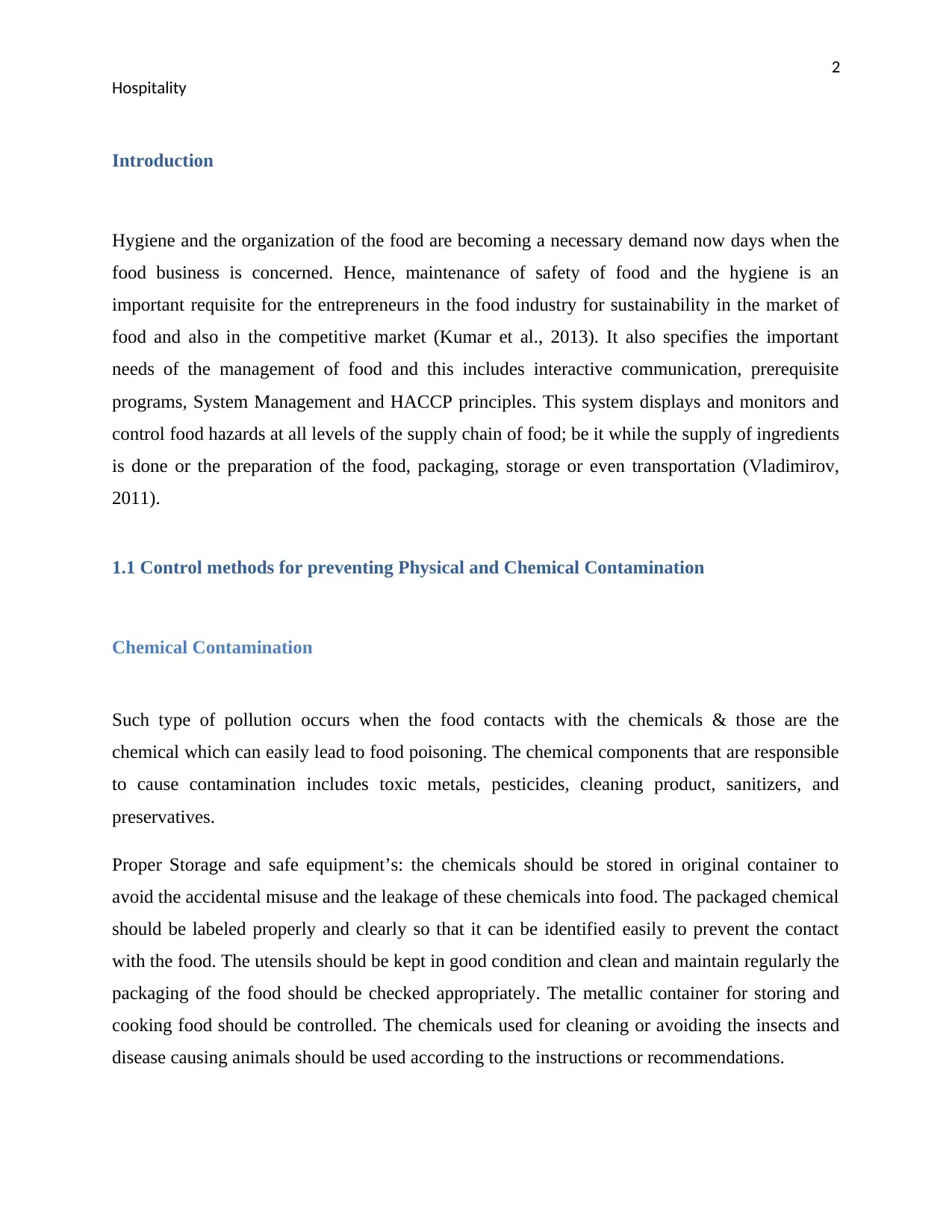
2
Hospitality
Introduction
Hygiene and the organization of the food are becoming a necessary demand now days when the
food business is concerned. Hence, maintenance of safety of food and the hygiene is an
important requisite for the entrepreneurs in the food industry for sustainability in the market of
food and also in the competitive market (Kumar et al., 2013). It also specifies the important
needs of the management of food and this includes interactive communication, prerequisite
programs, System Management and HACCP principles. This system displays and monitors and
control food hazards at all levels of the supply chain of food; be it while the supply of ingredients
is done or the preparation of the food, packaging, storage or even transportation (Vladimirov,
2011).
1.1 Control methods for preventing Physical and Chemical Contamination
Chemical Contamination
Such type of pollution occurs when the food contacts with the chemicals & those are the
chemical which can easily lead to food poisoning. The chemical components that are responsible
to cause contamination includes toxic metals, pesticides, cleaning product, sanitizers, and
preservatives.
Proper Storage and safe equipment’s: the chemicals should be stored in original container to
avoid the accidental misuse and the leakage of these chemicals into food. The packaged chemical
should be labeled properly and clearly so that it can be identified easily to prevent the contact
with the food. The utensils should be kept in good condition and clean and maintain regularly the
packaging of the food should be checked appropriately. The metallic container for storing and
cooking food should be controlled. The chemicals used for cleaning or avoiding the insects and
disease causing animals should be used according to the instructions or recommendations.
Hospitality
Introduction
Hygiene and the organization of the food are becoming a necessary demand now days when the
food business is concerned. Hence, maintenance of safety of food and the hygiene is an
important requisite for the entrepreneurs in the food industry for sustainability in the market of
food and also in the competitive market (Kumar et al., 2013). It also specifies the important
needs of the management of food and this includes interactive communication, prerequisite
programs, System Management and HACCP principles. This system displays and monitors and
control food hazards at all levels of the supply chain of food; be it while the supply of ingredients
is done or the preparation of the food, packaging, storage or even transportation (Vladimirov,
2011).
1.1 Control methods for preventing Physical and Chemical Contamination
Chemical Contamination
Such type of pollution occurs when the food contacts with the chemicals & those are the
chemical which can easily lead to food poisoning. The chemical components that are responsible
to cause contamination includes toxic metals, pesticides, cleaning product, sanitizers, and
preservatives.
Proper Storage and safe equipment’s: the chemicals should be stored in original container to
avoid the accidental misuse and the leakage of these chemicals into food. The packaged chemical
should be labeled properly and clearly so that it can be identified easily to prevent the contact
with the food. The utensils should be kept in good condition and clean and maintain regularly the
packaging of the food should be checked appropriately. The metallic container for storing and
cooking food should be controlled. The chemicals used for cleaning or avoiding the insects and
disease causing animals should be used according to the instructions or recommendations.
⊘ This is a preview!⊘
Do you want full access?
Subscribe today to unlock all pages.

Trusted by 1+ million students worldwide
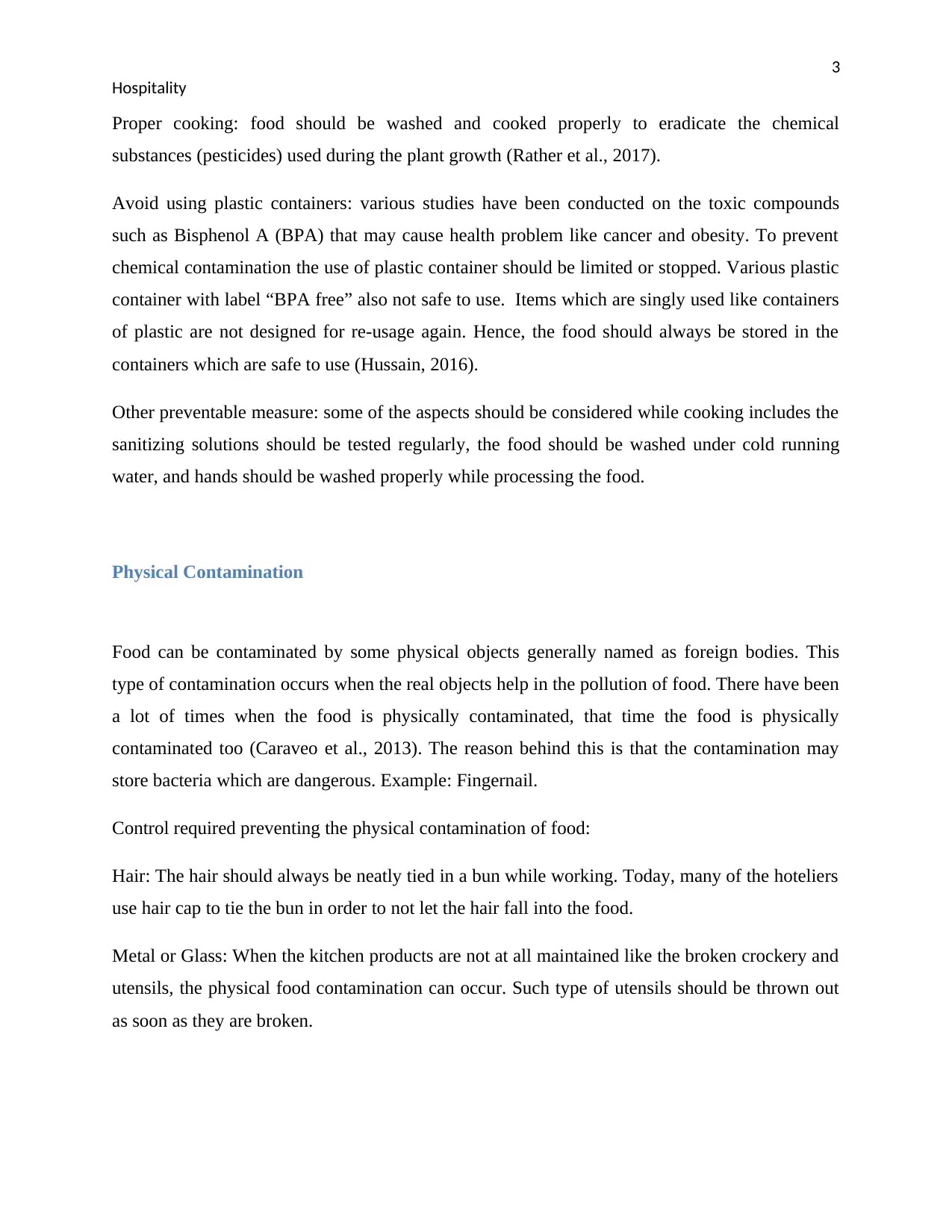
3
Hospitality
Proper cooking: food should be washed and cooked properly to eradicate the chemical
substances (pesticides) used during the plant growth (Rather et al., 2017).
Avoid using plastic containers: various studies have been conducted on the toxic compounds
such as Bisphenol A (BPA) that may cause health problem like cancer and obesity. To prevent
chemical contamination the use of plastic container should be limited or stopped. Various plastic
container with label “BPA free” also not safe to use. Items which are singly used like containers
of plastic are not designed for re-usage again. Hence, the food should always be stored in the
containers which are safe to use (Hussain, 2016).
Other preventable measure: some of the aspects should be considered while cooking includes the
sanitizing solutions should be tested regularly, the food should be washed under cold running
water, and hands should be washed properly while processing the food.
Physical Contamination
Food can be contaminated by some physical objects generally named as foreign bodies. This
type of contamination occurs when the real objects help in the pollution of food. There have been
a lot of times when the food is physically contaminated, that time the food is physically
contaminated too (Caraveo et al., 2013). The reason behind this is that the contamination may
store bacteria which are dangerous. Example: Fingernail.
Control required preventing the physical contamination of food:
Hair: The hair should always be neatly tied in a bun while working. Today, many of the hoteliers
use hair cap to tie the bun in order to not let the hair fall into the food.
Metal or Glass: When the kitchen products are not at all maintained like the broken crockery and
utensils, the physical food contamination can occur. Such type of utensils should be thrown out
as soon as they are broken.
Hospitality
Proper cooking: food should be washed and cooked properly to eradicate the chemical
substances (pesticides) used during the plant growth (Rather et al., 2017).
Avoid using plastic containers: various studies have been conducted on the toxic compounds
such as Bisphenol A (BPA) that may cause health problem like cancer and obesity. To prevent
chemical contamination the use of plastic container should be limited or stopped. Various plastic
container with label “BPA free” also not safe to use. Items which are singly used like containers
of plastic are not designed for re-usage again. Hence, the food should always be stored in the
containers which are safe to use (Hussain, 2016).
Other preventable measure: some of the aspects should be considered while cooking includes the
sanitizing solutions should be tested regularly, the food should be washed under cold running
water, and hands should be washed properly while processing the food.
Physical Contamination
Food can be contaminated by some physical objects generally named as foreign bodies. This
type of contamination occurs when the real objects help in the pollution of food. There have been
a lot of times when the food is physically contaminated, that time the food is physically
contaminated too (Caraveo et al., 2013). The reason behind this is that the contamination may
store bacteria which are dangerous. Example: Fingernail.
Control required preventing the physical contamination of food:
Hair: The hair should always be neatly tied in a bun while working. Today, many of the hoteliers
use hair cap to tie the bun in order to not let the hair fall into the food.
Metal or Glass: When the kitchen products are not at all maintained like the broken crockery and
utensils, the physical food contamination can occur. Such type of utensils should be thrown out
as soon as they are broken.
Paraphrase This Document
Need a fresh take? Get an instant paraphrase of this document with our AI Paraphraser
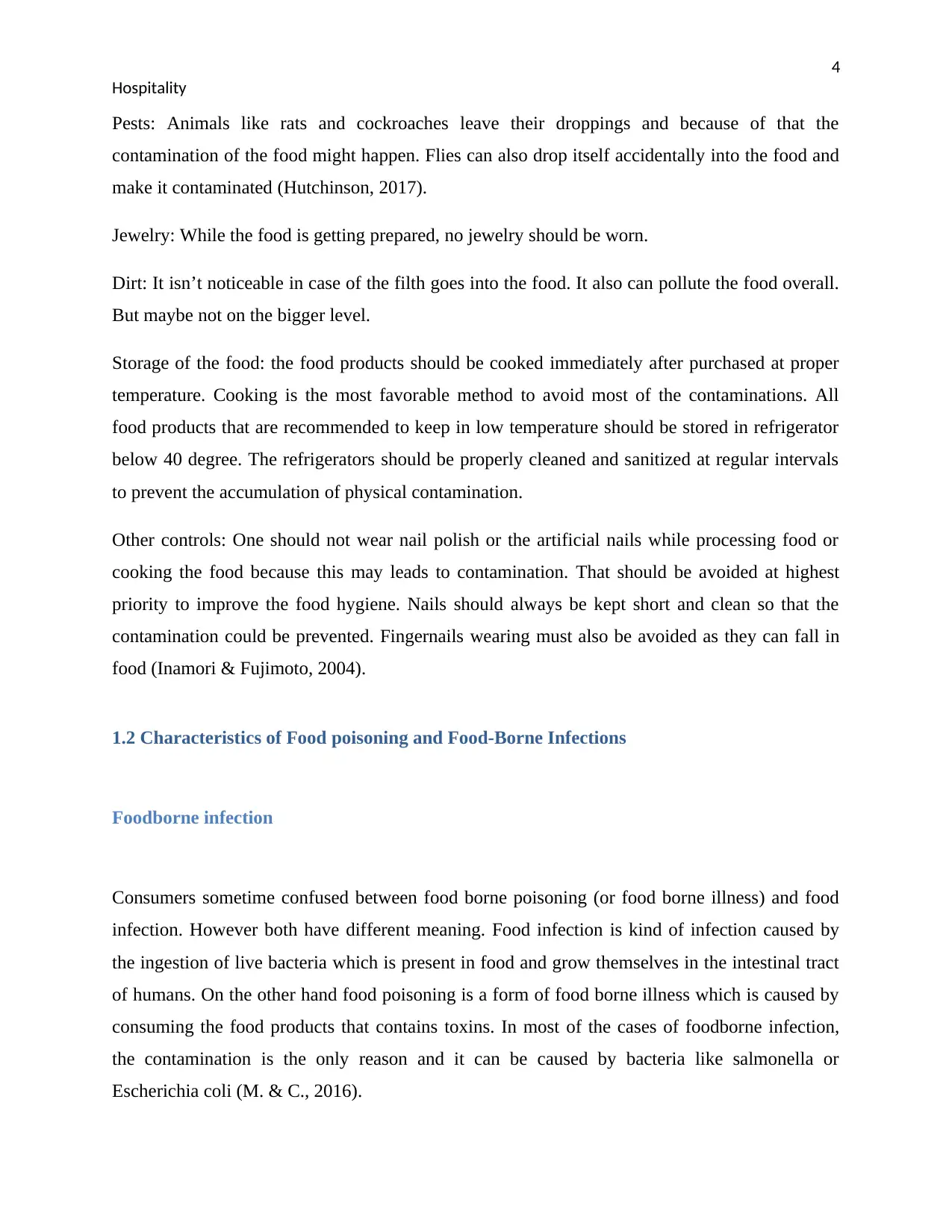
4
Hospitality
Pests: Animals like rats and cockroaches leave their droppings and because of that the
contamination of the food might happen. Flies can also drop itself accidentally into the food and
make it contaminated (Hutchinson, 2017).
Jewelry: While the food is getting prepared, no jewelry should be worn.
Dirt: It isn’t noticeable in case of the filth goes into the food. It also can pollute the food overall.
But maybe not on the bigger level.
Storage of the food: the food products should be cooked immediately after purchased at proper
temperature. Cooking is the most favorable method to avoid most of the contaminations. All
food products that are recommended to keep in low temperature should be stored in refrigerator
below 40 degree. The refrigerators should be properly cleaned and sanitized at regular intervals
to prevent the accumulation of physical contamination.
Other controls: One should not wear nail polish or the artificial nails while processing food or
cooking the food because this may leads to contamination. That should be avoided at highest
priority to improve the food hygiene. Nails should always be kept short and clean so that the
contamination could be prevented. Fingernails wearing must also be avoided as they can fall in
food (Inamori & Fujimoto, 2004).
1.2 Characteristics of Food poisoning and Food-Borne Infections
Foodborne infection
Consumers sometime confused between food borne poisoning (or food borne illness) and food
infection. However both have different meaning. Food infection is kind of infection caused by
the ingestion of live bacteria which is present in food and grow themselves in the intestinal tract
of humans. On the other hand food poisoning is a form of food borne illness which is caused by
consuming the food products that contains toxins. In most of the cases of foodborne infection,
the contamination is the only reason and it can be caused by bacteria like salmonella or
Escherichia coli (M. & C., 2016).
Hospitality
Pests: Animals like rats and cockroaches leave their droppings and because of that the
contamination of the food might happen. Flies can also drop itself accidentally into the food and
make it contaminated (Hutchinson, 2017).
Jewelry: While the food is getting prepared, no jewelry should be worn.
Dirt: It isn’t noticeable in case of the filth goes into the food. It also can pollute the food overall.
But maybe not on the bigger level.
Storage of the food: the food products should be cooked immediately after purchased at proper
temperature. Cooking is the most favorable method to avoid most of the contaminations. All
food products that are recommended to keep in low temperature should be stored in refrigerator
below 40 degree. The refrigerators should be properly cleaned and sanitized at regular intervals
to prevent the accumulation of physical contamination.
Other controls: One should not wear nail polish or the artificial nails while processing food or
cooking the food because this may leads to contamination. That should be avoided at highest
priority to improve the food hygiene. Nails should always be kept short and clean so that the
contamination could be prevented. Fingernails wearing must also be avoided as they can fall in
food (Inamori & Fujimoto, 2004).
1.2 Characteristics of Food poisoning and Food-Borne Infections
Foodborne infection
Consumers sometime confused between food borne poisoning (or food borne illness) and food
infection. However both have different meaning. Food infection is kind of infection caused by
the ingestion of live bacteria which is present in food and grow themselves in the intestinal tract
of humans. On the other hand food poisoning is a form of food borne illness which is caused by
consuming the food products that contains toxins. In most of the cases of foodborne infection,
the contamination is the only reason and it can be caused by bacteria like salmonella or
Escherichia coli (M. & C., 2016).
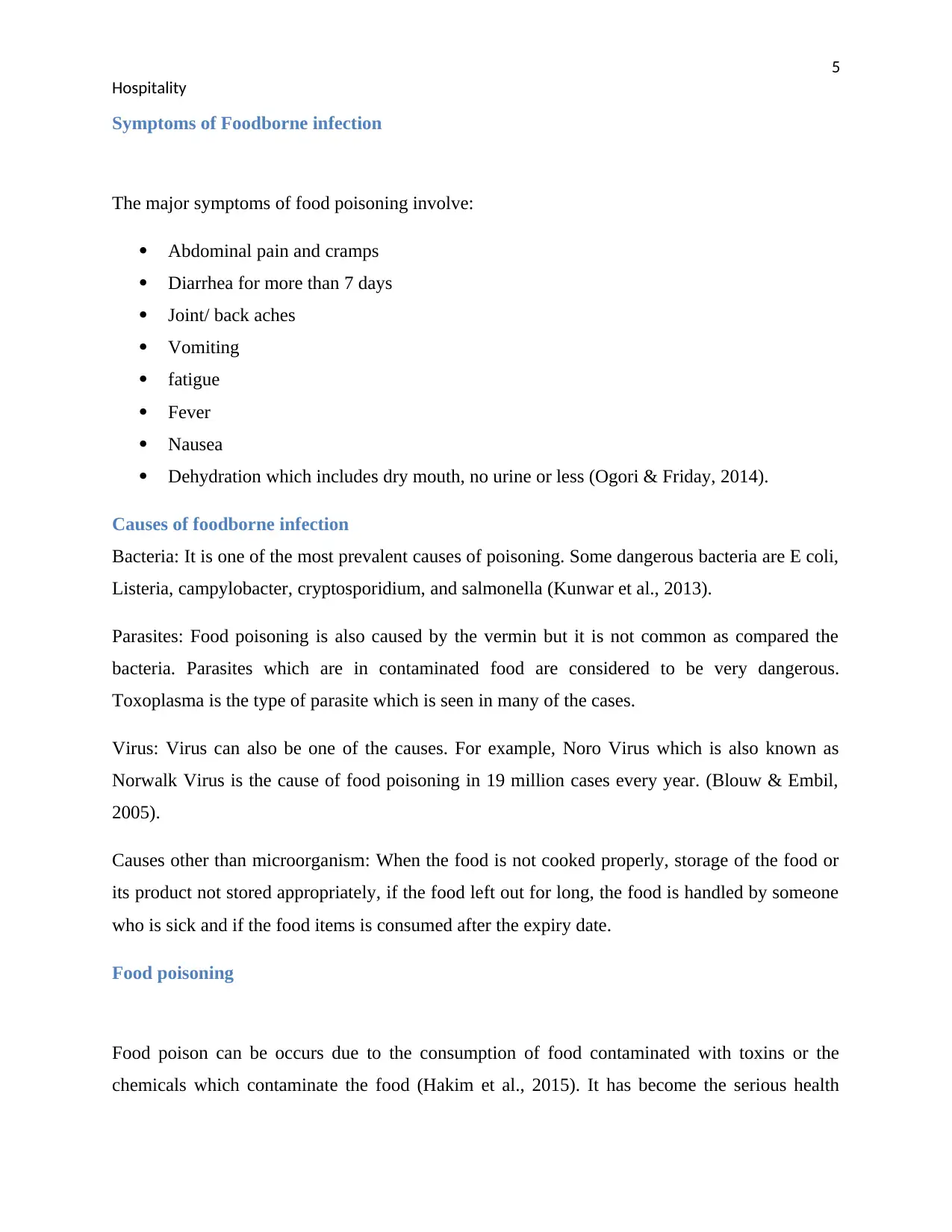
5
Hospitality
Symptoms of Foodborne infection
The major symptoms of food poisoning involve:
Abdominal pain and cramps
Diarrhea for more than 7 days
Joint/ back aches
Vomiting
fatigue
Fever
Nausea
Dehydration which includes dry mouth, no urine or less (Ogori & Friday, 2014).
Causes of foodborne infection
Bacteria: It is one of the most prevalent causes of poisoning. Some dangerous bacteria are E coli,
Listeria, campylobacter, cryptosporidium, and salmonella (Kunwar et al., 2013).
Parasites: Food poisoning is also caused by the vermin but it is not common as compared the
bacteria. Parasites which are in contaminated food are considered to be very dangerous.
Toxoplasma is the type of parasite which is seen in many of the cases.
Virus: Virus can also be one of the causes. For example, Noro Virus which is also known as
Norwalk Virus is the cause of food poisoning in 19 million cases every year. (Blouw & Embil,
2005).
Causes other than microorganism: When the food is not cooked properly, storage of the food or
its product not stored appropriately, if the food left out for long, the food is handled by someone
who is sick and if the food items is consumed after the expiry date.
Food poisoning
Food poison can be occurs due to the consumption of food contaminated with toxins or the
chemicals which contaminate the food (Hakim et al., 2015). It has become the serious health
Hospitality
Symptoms of Foodborne infection
The major symptoms of food poisoning involve:
Abdominal pain and cramps
Diarrhea for more than 7 days
Joint/ back aches
Vomiting
fatigue
Fever
Nausea
Dehydration which includes dry mouth, no urine or less (Ogori & Friday, 2014).
Causes of foodborne infection
Bacteria: It is one of the most prevalent causes of poisoning. Some dangerous bacteria are E coli,
Listeria, campylobacter, cryptosporidium, and salmonella (Kunwar et al., 2013).
Parasites: Food poisoning is also caused by the vermin but it is not common as compared the
bacteria. Parasites which are in contaminated food are considered to be very dangerous.
Toxoplasma is the type of parasite which is seen in many of the cases.
Virus: Virus can also be one of the causes. For example, Noro Virus which is also known as
Norwalk Virus is the cause of food poisoning in 19 million cases every year. (Blouw & Embil,
2005).
Causes other than microorganism: When the food is not cooked properly, storage of the food or
its product not stored appropriately, if the food left out for long, the food is handled by someone
who is sick and if the food items is consumed after the expiry date.
Food poisoning
Food poison can be occurs due to the consumption of food contaminated with toxins or the
chemicals which contaminate the food (Hakim et al., 2015). It has become the serious health
⊘ This is a preview!⊘
Do you want full access?
Subscribe today to unlock all pages.

Trusted by 1+ million students worldwide
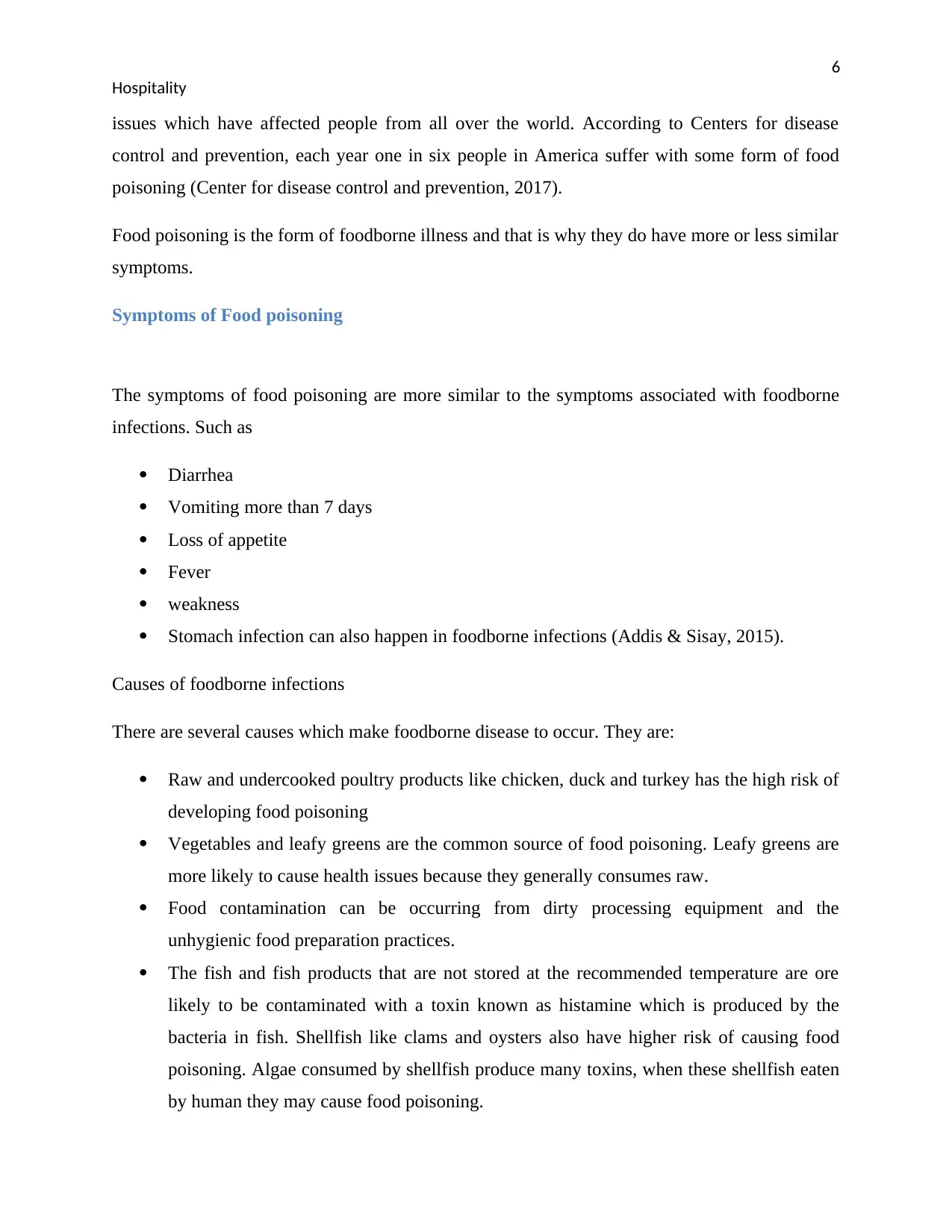
6
Hospitality
issues which have affected people from all over the world. According to Centers for disease
control and prevention, each year one in six people in America suffer with some form of food
poisoning (Center for disease control and prevention, 2017).
Food poisoning is the form of foodborne illness and that is why they do have more or less similar
symptoms.
Symptoms of Food poisoning
The symptoms of food poisoning are more similar to the symptoms associated with foodborne
infections. Such as
Diarrhea
Vomiting more than 7 days
Loss of appetite
Fever
weakness
Stomach infection can also happen in foodborne infections (Addis & Sisay, 2015).
Causes of foodborne infections
There are several causes which make foodborne disease to occur. They are:
Raw and undercooked poultry products like chicken, duck and turkey has the high risk of
developing food poisoning
Vegetables and leafy greens are the common source of food poisoning. Leafy greens are
more likely to cause health issues because they generally consumes raw.
Food contamination can be occurring from dirty processing equipment and the
unhygienic food preparation practices.
The fish and fish products that are not stored at the recommended temperature are ore
likely to be contaminated with a toxin known as histamine which is produced by the
bacteria in fish. Shellfish like clams and oysters also have higher risk of causing food
poisoning. Algae consumed by shellfish produce many toxins, when these shellfish eaten
by human they may cause food poisoning.
Hospitality
issues which have affected people from all over the world. According to Centers for disease
control and prevention, each year one in six people in America suffer with some form of food
poisoning (Center for disease control and prevention, 2017).
Food poisoning is the form of foodborne illness and that is why they do have more or less similar
symptoms.
Symptoms of Food poisoning
The symptoms of food poisoning are more similar to the symptoms associated with foodborne
infections. Such as
Diarrhea
Vomiting more than 7 days
Loss of appetite
Fever
weakness
Stomach infection can also happen in foodborne infections (Addis & Sisay, 2015).
Causes of foodborne infections
There are several causes which make foodborne disease to occur. They are:
Raw and undercooked poultry products like chicken, duck and turkey has the high risk of
developing food poisoning
Vegetables and leafy greens are the common source of food poisoning. Leafy greens are
more likely to cause health issues because they generally consumes raw.
Food contamination can be occurring from dirty processing equipment and the
unhygienic food preparation practices.
The fish and fish products that are not stored at the recommended temperature are ore
likely to be contaminated with a toxin known as histamine which is produced by the
bacteria in fish. Shellfish like clams and oysters also have higher risk of causing food
poisoning. Algae consumed by shellfish produce many toxins, when these shellfish eaten
by human they may cause food poisoning.
Paraphrase This Document
Need a fresh take? Get an instant paraphrase of this document with our AI Paraphraser
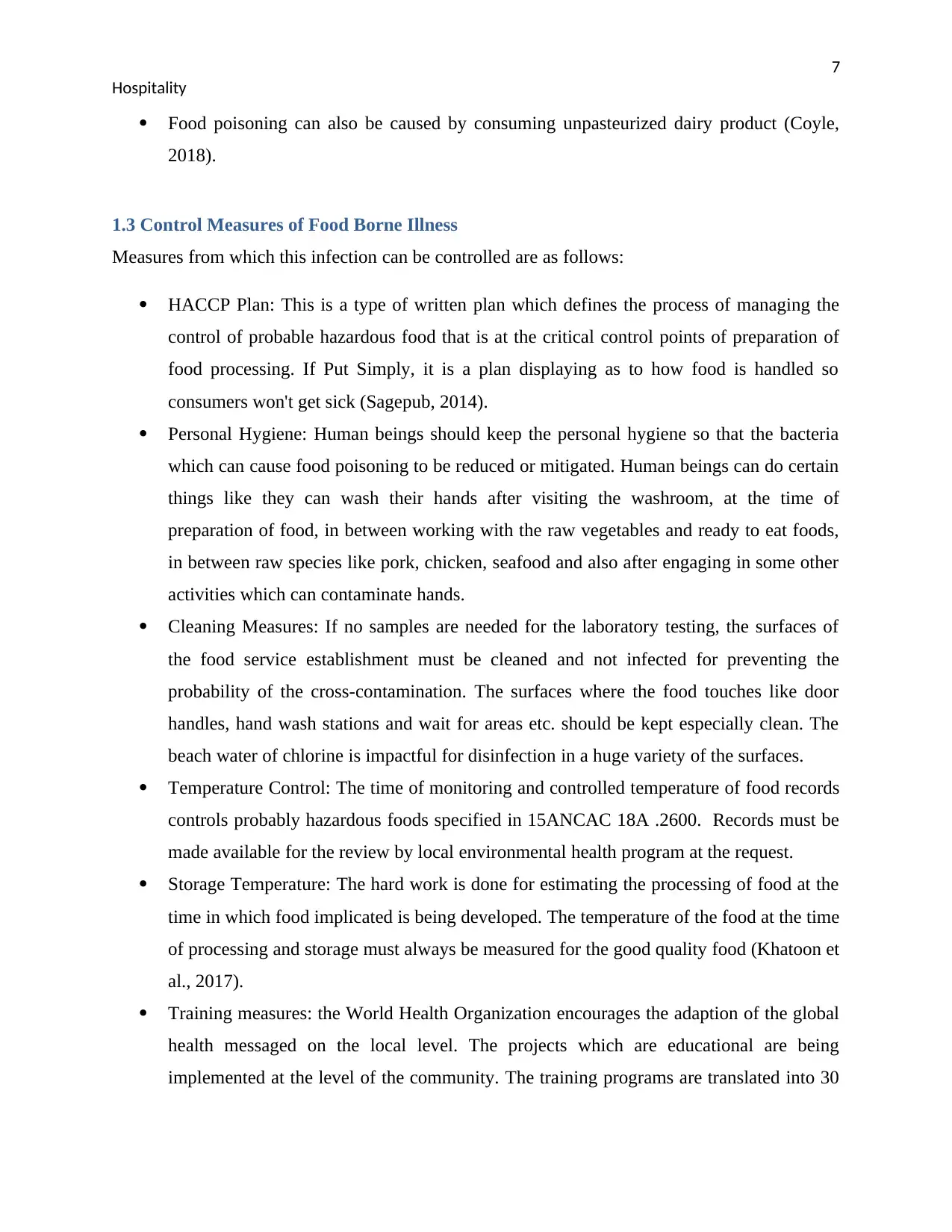
7
Hospitality
Food poisoning can also be caused by consuming unpasteurized dairy product (Coyle,
2018).
1.3 Control Measures of Food Borne Illness
Measures from which this infection can be controlled are as follows:
HACCP Plan: This is a type of written plan which defines the process of managing the
control of probable hazardous food that is at the critical control points of preparation of
food processing. If Put Simply, it is a plan displaying as to how food is handled so
consumers won't get sick (Sagepub, 2014).
Personal Hygiene: Human beings should keep the personal hygiene so that the bacteria
which can cause food poisoning to be reduced or mitigated. Human beings can do certain
things like they can wash their hands after visiting the washroom, at the time of
preparation of food, in between working with the raw vegetables and ready to eat foods,
in between raw species like pork, chicken, seafood and also after engaging in some other
activities which can contaminate hands.
Cleaning Measures: If no samples are needed for the laboratory testing, the surfaces of
the food service establishment must be cleaned and not infected for preventing the
probability of the cross-contamination. The surfaces where the food touches like door
handles, hand wash stations and wait for areas etc. should be kept especially clean. The
beach water of chlorine is impactful for disinfection in a huge variety of the surfaces.
Temperature Control: The time of monitoring and controlled temperature of food records
controls probably hazardous foods specified in 15ANCAC 18A .2600. Records must be
made available for the review by local environmental health program at the request.
Storage Temperature: The hard work is done for estimating the processing of food at the
time in which food implicated is being developed. The temperature of the food at the time
of processing and storage must always be measured for the good quality food (Khatoon et
al., 2017).
Training measures: the World Health Organization encourages the adaption of the global
health messaged on the local level. The projects which are educational are being
implemented at the level of the community. The training programs are translated into 30
Hospitality
Food poisoning can also be caused by consuming unpasteurized dairy product (Coyle,
2018).
1.3 Control Measures of Food Borne Illness
Measures from which this infection can be controlled are as follows:
HACCP Plan: This is a type of written plan which defines the process of managing the
control of probable hazardous food that is at the critical control points of preparation of
food processing. If Put Simply, it is a plan displaying as to how food is handled so
consumers won't get sick (Sagepub, 2014).
Personal Hygiene: Human beings should keep the personal hygiene so that the bacteria
which can cause food poisoning to be reduced or mitigated. Human beings can do certain
things like they can wash their hands after visiting the washroom, at the time of
preparation of food, in between working with the raw vegetables and ready to eat foods,
in between raw species like pork, chicken, seafood and also after engaging in some other
activities which can contaminate hands.
Cleaning Measures: If no samples are needed for the laboratory testing, the surfaces of
the food service establishment must be cleaned and not infected for preventing the
probability of the cross-contamination. The surfaces where the food touches like door
handles, hand wash stations and wait for areas etc. should be kept especially clean. The
beach water of chlorine is impactful for disinfection in a huge variety of the surfaces.
Temperature Control: The time of monitoring and controlled temperature of food records
controls probably hazardous foods specified in 15ANCAC 18A .2600. Records must be
made available for the review by local environmental health program at the request.
Storage Temperature: The hard work is done for estimating the processing of food at the
time in which food implicated is being developed. The temperature of the food at the time
of processing and storage must always be measured for the good quality food (Khatoon et
al., 2017).
Training measures: the World Health Organization encourages the adaption of the global
health messaged on the local level. The projects which are educational are being
implemented at the level of the community. The training programs are translated into 30
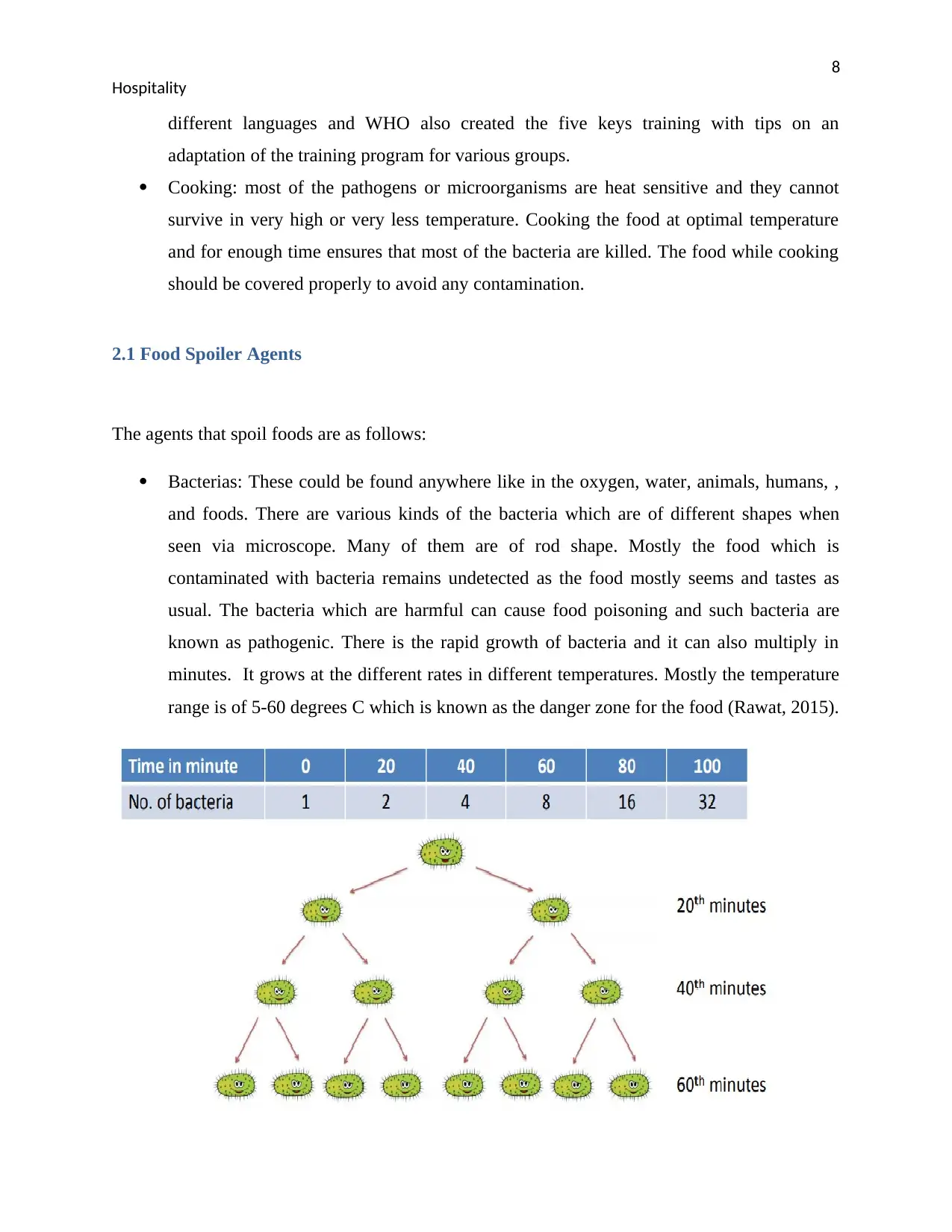
8
Hospitality
different languages and WHO also created the five keys training with tips on an
adaptation of the training program for various groups.
Cooking: most of the pathogens or microorganisms are heat sensitive and they cannot
survive in very high or very less temperature. Cooking the food at optimal temperature
and for enough time ensures that most of the bacteria are killed. The food while cooking
should be covered properly to avoid any contamination.
2.1 Food Spoiler Agents
The agents that spoil foods are as follows:
Bacterias: These could be found anywhere like in the oxygen, water, animals, humans, ,
and foods. There are various kinds of the bacteria which are of different shapes when
seen via microscope. Many of them are of rod shape. Mostly the food which is
contaminated with bacteria remains undetected as the food mostly seems and tastes as
usual. The bacteria which are harmful can cause food poisoning and such bacteria are
known as pathogenic. There is the rapid growth of bacteria and it can also multiply in
minutes. It grows at the different rates in different temperatures. Mostly the temperature
range is of 5-60 degrees C which is known as the danger zone for the food (Rawat, 2015).
Hospitality
different languages and WHO also created the five keys training with tips on an
adaptation of the training program for various groups.
Cooking: most of the pathogens or microorganisms are heat sensitive and they cannot
survive in very high or very less temperature. Cooking the food at optimal temperature
and for enough time ensures that most of the bacteria are killed. The food while cooking
should be covered properly to avoid any contamination.
2.1 Food Spoiler Agents
The agents that spoil foods are as follows:
Bacterias: These could be found anywhere like in the oxygen, water, animals, humans, ,
and foods. There are various kinds of the bacteria which are of different shapes when
seen via microscope. Many of them are of rod shape. Mostly the food which is
contaminated with bacteria remains undetected as the food mostly seems and tastes as
usual. The bacteria which are harmful can cause food poisoning and such bacteria are
known as pathogenic. There is the rapid growth of bacteria and it can also multiply in
minutes. It grows at the different rates in different temperatures. Mostly the temperature
range is of 5-60 degrees C which is known as the danger zone for the food (Rawat, 2015).
⊘ This is a preview!⊘
Do you want full access?
Subscribe today to unlock all pages.

Trusted by 1+ million students worldwide
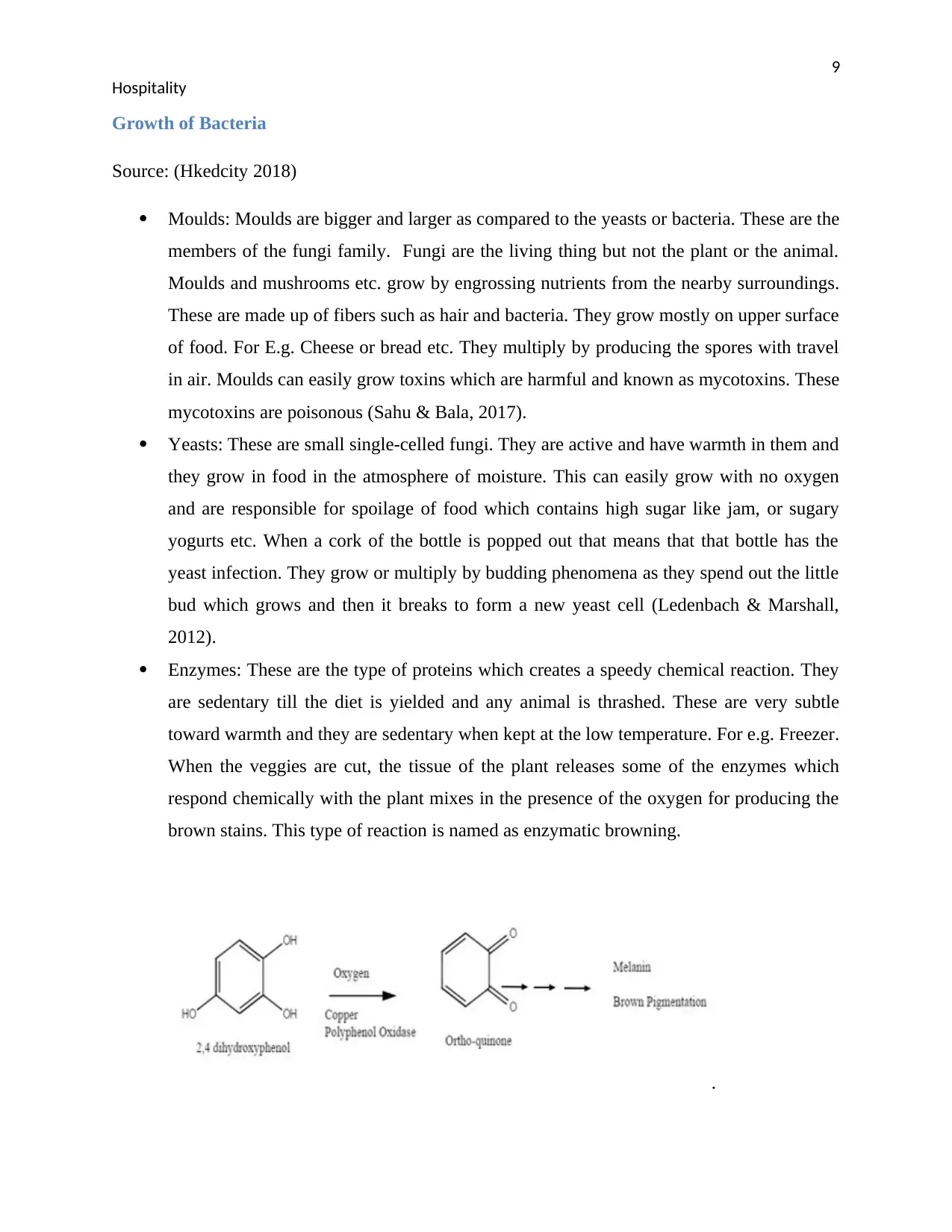
9
Hospitality
Growth of Bacteria
Source: (Hkedcity 2018)
Moulds: Moulds are bigger and larger as compared to the yeasts or bacteria. These are the
members of the fungi family. Fungi are the living thing but not the plant or the animal.
Moulds and mushrooms etc. grow by engrossing nutrients from the nearby surroundings.
These are made up of fibers such as hair and bacteria. They grow mostly on upper surface
of food. For E.g. Cheese or bread etc. They multiply by producing the spores with travel
in air. Moulds can easily grow toxins which are harmful and known as mycotoxins. These
mycotoxins are poisonous (Sahu & Bala, 2017).
Yeasts: These are small single-celled fungi. They are active and have warmth in them and
they grow in food in the atmosphere of moisture. This can easily grow with no oxygen
and are responsible for spoilage of food which contains high sugar like jam, or sugary
yogurts etc. When a cork of the bottle is popped out that means that that bottle has the
yeast infection. They grow or multiply by budding phenomena as they spend out the little
bud which grows and then it breaks to form a new yeast cell (Ledenbach & Marshall,
2012).
Enzymes: These are the type of proteins which creates a speedy chemical reaction. They
are sedentary till the diet is yielded and any animal is thrashed. These are very subtle
toward warmth and they are sedentary when kept at the low temperature. For e.g. Freezer.
When the veggies are cut, the tissue of the plant releases some of the enzymes which
respond chemically with the plant mixes in the presence of the oxygen for producing the
brown stains. This type of reaction is named as enzymatic browning.
.
Hospitality
Growth of Bacteria
Source: (Hkedcity 2018)
Moulds: Moulds are bigger and larger as compared to the yeasts or bacteria. These are the
members of the fungi family. Fungi are the living thing but not the plant or the animal.
Moulds and mushrooms etc. grow by engrossing nutrients from the nearby surroundings.
These are made up of fibers such as hair and bacteria. They grow mostly on upper surface
of food. For E.g. Cheese or bread etc. They multiply by producing the spores with travel
in air. Moulds can easily grow toxins which are harmful and known as mycotoxins. These
mycotoxins are poisonous (Sahu & Bala, 2017).
Yeasts: These are small single-celled fungi. They are active and have warmth in them and
they grow in food in the atmosphere of moisture. This can easily grow with no oxygen
and are responsible for spoilage of food which contains high sugar like jam, or sugary
yogurts etc. When a cork of the bottle is popped out that means that that bottle has the
yeast infection. They grow or multiply by budding phenomena as they spend out the little
bud which grows and then it breaks to form a new yeast cell (Ledenbach & Marshall,
2012).
Enzymes: These are the type of proteins which creates a speedy chemical reaction. They
are sedentary till the diet is yielded and any animal is thrashed. These are very subtle
toward warmth and they are sedentary when kept at the low temperature. For e.g. Freezer.
When the veggies are cut, the tissue of the plant releases some of the enzymes which
respond chemically with the plant mixes in the presence of the oxygen for producing the
brown stains. This type of reaction is named as enzymatic browning.
.
Paraphrase This Document
Need a fresh take? Get an instant paraphrase of this document with our AI Paraphraser
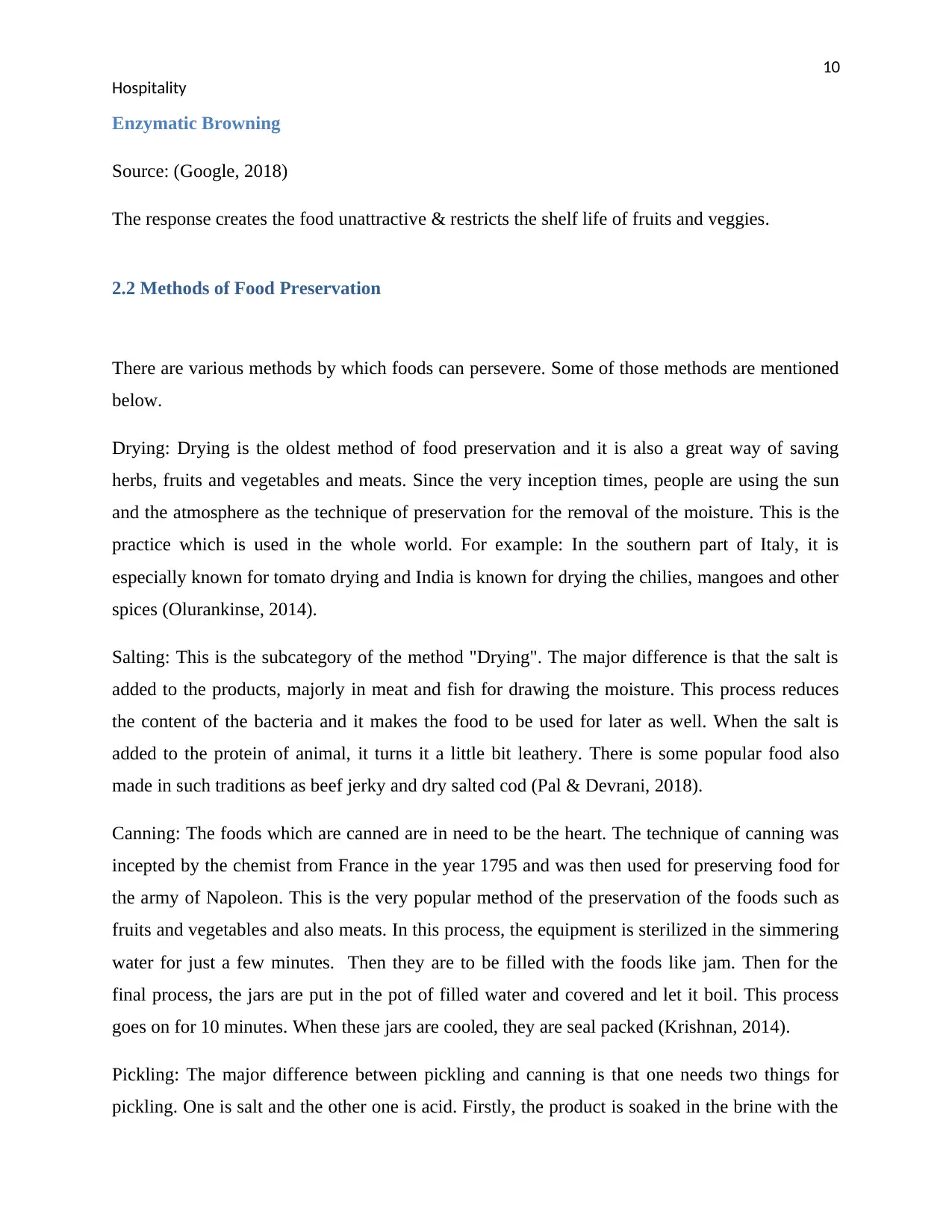
10
Hospitality
Enzymatic Browning
Source: (Google, 2018)
The response creates the food unattractive & restricts the shelf life of fruits and veggies.
2.2 Methods of Food Preservation
There are various methods by which foods can persevere. Some of those methods are mentioned
below.
Drying: Drying is the oldest method of food preservation and it is also a great way of saving
herbs, fruits and vegetables and meats. Since the very inception times, people are using the sun
and the atmosphere as the technique of preservation for the removal of the moisture. This is the
practice which is used in the whole world. For example: In the southern part of Italy, it is
especially known for tomato drying and India is known for drying the chilies, mangoes and other
spices (Olurankinse, 2014).
Salting: This is the subcategory of the method "Drying". The major difference is that the salt is
added to the products, majorly in meat and fish for drawing the moisture. This process reduces
the content of the bacteria and it makes the food to be used for later as well. When the salt is
added to the protein of animal, it turns it a little bit leathery. There is some popular food also
made in such traditions as beef jerky and dry salted cod (Pal & Devrani, 2018).
Canning: The foods which are canned are in need to be the heart. The technique of canning was
incepted by the chemist from France in the year 1795 and was then used for preserving food for
the army of Napoleon. This is the very popular method of the preservation of the foods such as
fruits and vegetables and also meats. In this process, the equipment is sterilized in the simmering
water for just a few minutes. Then they are to be filled with the foods like jam. Then for the
final process, the jars are put in the pot of filled water and covered and let it boil. This process
goes on for 10 minutes. When these jars are cooled, they are seal packed (Krishnan, 2014).
Pickling: The major difference between pickling and canning is that one needs two things for
pickling. One is salt and the other one is acid. Firstly, the product is soaked in the brine with the
Hospitality
Enzymatic Browning
Source: (Google, 2018)
The response creates the food unattractive & restricts the shelf life of fruits and veggies.
2.2 Methods of Food Preservation
There are various methods by which foods can persevere. Some of those methods are mentioned
below.
Drying: Drying is the oldest method of food preservation and it is also a great way of saving
herbs, fruits and vegetables and meats. Since the very inception times, people are using the sun
and the atmosphere as the technique of preservation for the removal of the moisture. This is the
practice which is used in the whole world. For example: In the southern part of Italy, it is
especially known for tomato drying and India is known for drying the chilies, mangoes and other
spices (Olurankinse, 2014).
Salting: This is the subcategory of the method "Drying". The major difference is that the salt is
added to the products, majorly in meat and fish for drawing the moisture. This process reduces
the content of the bacteria and it makes the food to be used for later as well. When the salt is
added to the protein of animal, it turns it a little bit leathery. There is some popular food also
made in such traditions as beef jerky and dry salted cod (Pal & Devrani, 2018).
Canning: The foods which are canned are in need to be the heart. The technique of canning was
incepted by the chemist from France in the year 1795 and was then used for preserving food for
the army of Napoleon. This is the very popular method of the preservation of the foods such as
fruits and vegetables and also meats. In this process, the equipment is sterilized in the simmering
water for just a few minutes. Then they are to be filled with the foods like jam. Then for the
final process, the jars are put in the pot of filled water and covered and let it boil. This process
goes on for 10 minutes. When these jars are cooled, they are seal packed (Krishnan, 2014).
Pickling: The major difference between pickling and canning is that one needs two things for
pickling. One is salt and the other one is acid. Firstly, the product is soaked in the brine with the
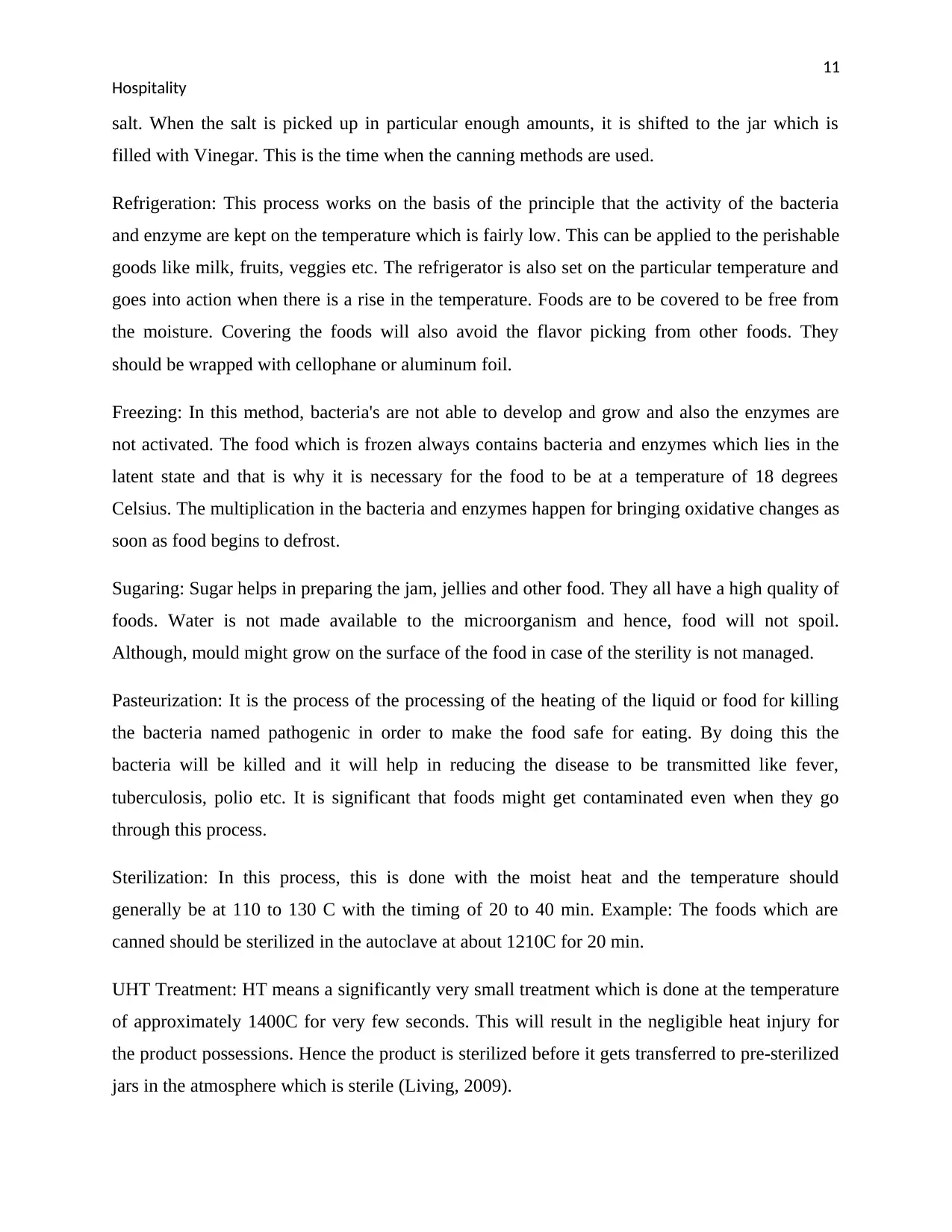
11
Hospitality
salt. When the salt is picked up in particular enough amounts, it is shifted to the jar which is
filled with Vinegar. This is the time when the canning methods are used.
Refrigeration: This process works on the basis of the principle that the activity of the bacteria
and enzyme are kept on the temperature which is fairly low. This can be applied to the perishable
goods like milk, fruits, veggies etc. The refrigerator is also set on the particular temperature and
goes into action when there is a rise in the temperature. Foods are to be covered to be free from
the moisture. Covering the foods will also avoid the flavor picking from other foods. They
should be wrapped with cellophane or aluminum foil.
Freezing: In this method, bacteria's are not able to develop and grow and also the enzymes are
not activated. The food which is frozen always contains bacteria and enzymes which lies in the
latent state and that is why it is necessary for the food to be at a temperature of 18 degrees
Celsius. The multiplication in the bacteria and enzymes happen for bringing oxidative changes as
soon as food begins to defrost.
Sugaring: Sugar helps in preparing the jam, jellies and other food. They all have a high quality of
foods. Water is not made available to the microorganism and hence, food will not spoil.
Although, mould might grow on the surface of the food in case of the sterility is not managed.
Pasteurization: It is the process of the processing of the heating of the liquid or food for killing
the bacteria named pathogenic in order to make the food safe for eating. By doing this the
bacteria will be killed and it will help in reducing the disease to be transmitted like fever,
tuberculosis, polio etc. It is significant that foods might get contaminated even when they go
through this process.
Sterilization: In this process, this is done with the moist heat and the temperature should
generally be at 110 to 130 C with the timing of 20 to 40 min. Example: The foods which are
canned should be sterilized in the autoclave at about 1210C for 20 min.
UHT Treatment: HT means a significantly very small treatment which is done at the temperature
of approximately 1400C for very few seconds. This will result in the negligible heat injury for
the product possessions. Hence the product is sterilized before it gets transferred to pre-sterilized
jars in the atmosphere which is sterile (Living, 2009).
Hospitality
salt. When the salt is picked up in particular enough amounts, it is shifted to the jar which is
filled with Vinegar. This is the time when the canning methods are used.
Refrigeration: This process works on the basis of the principle that the activity of the bacteria
and enzyme are kept on the temperature which is fairly low. This can be applied to the perishable
goods like milk, fruits, veggies etc. The refrigerator is also set on the particular temperature and
goes into action when there is a rise in the temperature. Foods are to be covered to be free from
the moisture. Covering the foods will also avoid the flavor picking from other foods. They
should be wrapped with cellophane or aluminum foil.
Freezing: In this method, bacteria's are not able to develop and grow and also the enzymes are
not activated. The food which is frozen always contains bacteria and enzymes which lies in the
latent state and that is why it is necessary for the food to be at a temperature of 18 degrees
Celsius. The multiplication in the bacteria and enzymes happen for bringing oxidative changes as
soon as food begins to defrost.
Sugaring: Sugar helps in preparing the jam, jellies and other food. They all have a high quality of
foods. Water is not made available to the microorganism and hence, food will not spoil.
Although, mould might grow on the surface of the food in case of the sterility is not managed.
Pasteurization: It is the process of the processing of the heating of the liquid or food for killing
the bacteria named pathogenic in order to make the food safe for eating. By doing this the
bacteria will be killed and it will help in reducing the disease to be transmitted like fever,
tuberculosis, polio etc. It is significant that foods might get contaminated even when they go
through this process.
Sterilization: In this process, this is done with the moist heat and the temperature should
generally be at 110 to 130 C with the timing of 20 to 40 min. Example: The foods which are
canned should be sterilized in the autoclave at about 1210C for 20 min.
UHT Treatment: HT means a significantly very small treatment which is done at the temperature
of approximately 1400C for very few seconds. This will result in the negligible heat injury for
the product possessions. Hence the product is sterilized before it gets transferred to pre-sterilized
jars in the atmosphere which is sterile (Living, 2009).
⊘ This is a preview!⊘
Do you want full access?
Subscribe today to unlock all pages.

Trusted by 1+ million students worldwide
1 out of 22
Related Documents
Your All-in-One AI-Powered Toolkit for Academic Success.
+13062052269
info@desklib.com
Available 24*7 on WhatsApp / Email
![[object Object]](/_next/static/media/star-bottom.7253800d.svg)
Unlock your academic potential
Copyright © 2020–2025 A2Z Services. All Rights Reserved. Developed and managed by ZUCOL.





